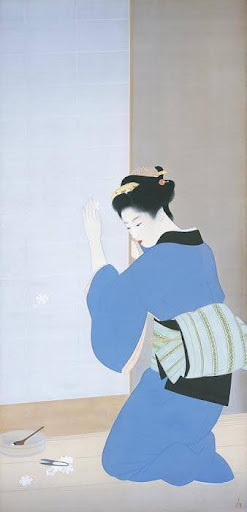13.晩秋(Late Autumn)
母への敬意と日常の美を讃える作品

《晩秋》は1943年に描いた作品で、彼女の晩年期にあたる代表作のひとつ。破れた障子に花形の紙を貼って修繕する女性の姿。これは松園が自身の母親の姿を重ねて描いたとされ、日常の中にある慎ましさと美しさを象徴している。青い着物に緑と白の帯を締めた女性が、静かに膝をついて障子に向かい、手を添えている姿。表情は見えないが、所作に込められた丁寧さと精神性が際立つ。床には白い花びらが散り、筆の入った器が置かれている。これらは季節感と生活感を演出し、秋の静けさと物思いを感じさせる。絹本彩色による柔らかな色彩と質感が、女性の肌や着物の風合いを繊細に表現、背景を簡素にすることで人物の存在感を際立たせている。松園特有の「理想化された女性像」ではなく、生活の中にある美しさを描いた点がこの作品の魅力である。
Late Autumn (1943)
A tribute to mothers and the beauty of everyday life
Painted in 1943, Late Autumn is one of Shōen Uemura’s representative works from her later years. It depicts a woman repairing a torn shoji screen by pasting flower-shaped paper over the damage—a scene believed to reflect Uemura’s own mother and her quiet dignity in daily life.
The woman, dressed in a blue kimono with a green and white sash, kneels calmly before the screen with her hands gently placed. Though her expression cannot be seen, her grace and a sense of spirituality can. Scattered white petals on the floor and a bowl containing brushes evoke both seasonal atmosphere and domestic intimacy, suggesting the quiet introspection of autumn.
Using color-on-silk techniques, Uemura renders the textures of skin and fabric with delicate softness. The simplified background enhances the presence of the figure. Unlike her idealized portraits of women, this work celebrates the understated beauty found in everyday life.
お問い合わせ
〒154-0024 東京都世田谷区三軒茶屋1-39-7